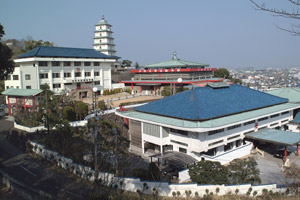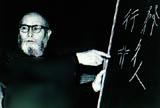Kids Web Japan
Web Japan > Kids Web Japan > Meet the Kids > Zenrin > Shorinji Kempo
Meet the Kids
Zenrin Gakuen
What Is Shorinji Kempo?

The school is located in the place where Shorinji Kempo was founded.
Shorinji Kempo was founded by So Doshin in 1947 in the town of Tadotsu. There are now some 1.5 million registered members of the Shorinji Kempo Federation worldwide, and national chapters have been established in 30 countries.
The biggest difference between Shorinji Kempo and other sports - and in fact other martial arts - is that the focus is not on competing to determine who is better or stronger or who the winners and losers are. It is to be used not to attack someone but to protect yourself and your loved ones. There are no contests, therefore, in which the object is to defeat one's opponent. There are competitions, but their purpose is to demonstrate the techniques one has learned and to have such demonstrations evaluated by others.

The founder of Shorinji Kempo, So Doshin
The founder placed importance on the role of Shorinji Kempo in personal growth. This is expressed in the phrase, "Live half for yourself and half for others." This means that anyone who does not value one's own life will be unable to value the lives of others. By studying Shorinji Kempo, one acquires not only self-confidence and courage but also an understanding of the importance - and joy - of cooperating with others. This is the big objective of this art.

Shorinji Kempo is based on the philosophy of "Live half for yourself and half for others."
There are many different techniques one must master, but they can be classified into three major types: goho (hard techniques), juho (soft techniques), and seiho (healing techniques). These three further branch out into a total of 25 patterns. All of them are based on a careful study of the human skeletal and muscular systems as well as the principles of nature, and they incorporate approaches to defense and counterattack.
Goho largely consist of strikes and kicks, while juho seeks to break an opponent's grasp using as little power as possible through releases, joint reverses, and pins. Differences in body size or strength are therefore not a primary element in Shorinji Kempo; this is why even a slightly built female student can practice with a much larger male student.